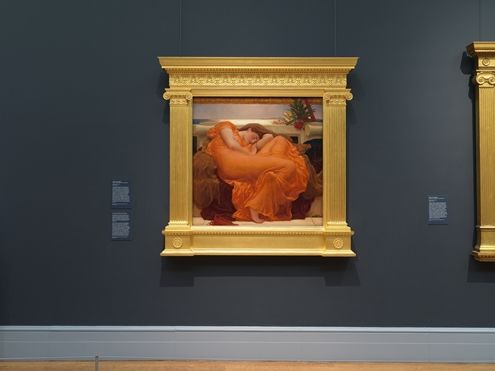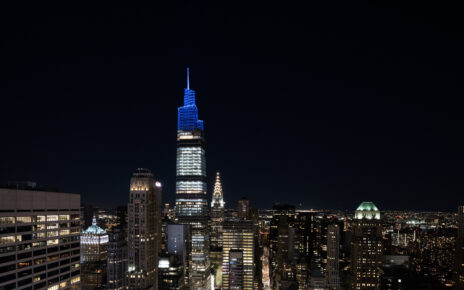NEW YORK — An installation of five Victorian masterpieces from the collection of the Museo de Arte de Ponce, Puerto Rico, is entering its final weeks at The Metropolitan Museum of Art. On display through February 4, 2024, the paintings have been on loan to The Met for over a year. This successful collaboration between the institutions includes the loan of Frederic Leighton’s Flaming June (1895), an icon of Victorian painting; John Everett Millais’s The Escape of a Heretic, 1559 (1857); and three scenes comprising the Small Briar Rose Series by Sir Edward Burne-Jones (all painted 1871–73).
“These five works are some of the most magnificent examples of Victorian painting in the world. Few works rival the beauty of Leighton’s Flaming June or the impressive artistry of Millais’s and Burne-Jones’s paintings,” said Max Hollein, The Met’s Marina Kellen French Director and Chief Executive Officer. “We have been delighted to exhibit them here for over a year now, offering our visitors the unique opportunity to view these incredible works from the Museo de Arte de Ponce in a meaningful dialogue with The Met’s own collection. We extend our gratitude to our colleagues in Puerto Rico for their generosity and partnership.”
The partnership followed the devastating effects of major earthquakes in Puerto Rico in 2020, when the structure of the Museo de Arte de Ponce was severely damaged and forced to close its main galleries. While undergoing significant repairs to ensure the structural integrity of the foundation, the museum quickly pivoted to use its platform to raise awareness of the devastation and challenges in Puerto Rico, while also seeking safe homes for its invaluable collection.
“This collaboration has allowed us to keep five of our beloved works, especially Flaming June, available to the public while repairs continue in our main galleries,” shared Rubí Rodríguez Bustillo, Deputy Director of the Museo de Arte de Ponce. “We hope that those who haven’t had the chance to see our paintings at The Met will do so prior to their departure in February.”
The selection of loans was made with an eye toward illuminating relationships between works in the Museo de Arte de Ponce’s and The Met’s collections. Flaming June and the Small Briar Rose Series, for example, are displayed along with works by Leighton and Burne-Jones in Gallery 800, a grand entryway to the European Paintings galleries. Gallery 808, the dedicated gallery for 19th-century British painting, hosts The Escape of a Heretic, 1559.
Most notably, the presentation brings together Flaming June and Leighton’s Lachrymae (1894–95, The Met). These are two of Leighton’s last monumental oils, made during the same painting campaign, and first exhibited, together, in the artist’s studio in 1895—yet their formal and thematic connections have never been fully appreciated. Although the two works have been in several exhibitions together, this is the first time that they are being displayed side by side. The installation reveals how the two paintings operate as a pair: Flaming June is a sensual celebration of life, and Lachrymae is its antithesis, a somber meditation on death.
The Small Briar Rose Series—The Prince Enters the Wood, The King and His Court, and The Sleeping Beauty—is displayed alongside Burne-Jones’s The Love Song (1868–77, The Met), which was commissioned by the same patron, William Graham, whose romantic tastes profoundly shaped the artist’s style. This reunion can occur only at The Met, as The Love Song’s fragile condition has prevented it from traveling since 2006.
The Escape of a Heretic, 1559 encapsulates the artistic development of Millais, the most accomplished of all the Pre-Raphaelites, as his stringent naturalism gave way to a more broadly appealing style.
In the weeks leading up to the display, Flaming June underwent technical examination and analysis in The Met’s Paintings Conservation and Scientific Research departments, using techniques including infrared reflectography, X-radiography, and macro-X-ray fluorescence. The painting has never before undergone such an in-depth study, raising the potential for new insights into the development of Leighton’s composition. This study is ongoing.
This partnership is coordinated by Iraida Rodríguez-Negrón, Curator of the Museo de Arte de Ponce, and Alison Hokanson, Associate Curator of European Paintings at The Met. Technical examination of Flaming June is being performed by Met staff members Charlotte Hale, Paintings Conservator; Silvia A. Centeno, Research Scientist; and Evan Read, Manager of Technical Documentation; in collaboration with Lidia Aravena, Chief Conservator at the Museo de Arte de Ponce.
“Research and examinations performed on our paintings while at The Met is imparting us with new scientific and scholarly knowledge about the works,” added Rodriguez Bustillo. “We consider this a gift from this special collaboration, and thank the wonderful staff at The Met and its scholars of British art for generously sharing their invaluable insights with us.”
The program was accompanied by a public lecture with talks by Malcolm Warner, independent scholar and author of the catalogue raisonné of works by John Everett Millais, and Alison Hokanson; and by a scholarly study day on Victorian Art at The Met, with an international roster of speakers and attendees.
The loans are featured on The Met website, along with a blog article on the history of Flaming June.
After this special installation concludes in February 2024, Leighton’s Flaming June will visit London where it will be exhibited at the Royal Academy until January 2025. Millais’s The Escape of a Heretic, 1559 and Burne-Jones’s Small Briar Rose Series will be part of the groundbreaking exhibition Pre-Raphaelites: A Modern Renaissance opening at the Musei San Domenico in Forlì, Italy on February 23, 2024.



